InterGlobe Aviation Bundle
How Did IndiGo Revolutionize Air Travel in India?
InterGlobe Aviation, better known as IndiGo, reshaped the InterGlobe Aviation SWOT Analysis landscape of the Indian aviation market. Founded in 2006, the airline's focus on the low-cost carrier (LCC) model democratized air travel, making it accessible to a wider audience. This strategic shift marked a pivotal moment in the
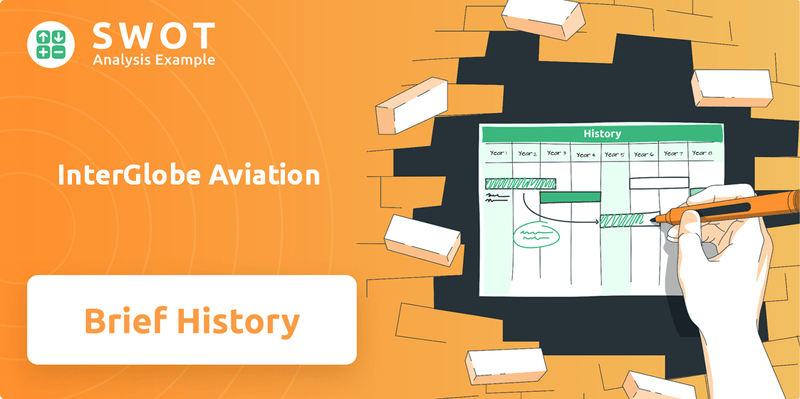
From its inception in Gurgaon, Haryana, IndiGo's commitment to affordability and operational efficiency set it apart. Its success is evident in its dominant market share of over 60% as of early 2024, a testament to its effective strategies. This article will explore the
What is the InterGlobe Aviation Founding Story?
The founding of InterGlobe Aviation Ltd., known widely as IndiGo, marks a significant chapter in the evolution of the Indian aviation market. Established on January 28, 2006, the company was the brainchild of Rahul Bhatia of InterGlobe Enterprises and Rakesh Gangwal, an aviation industry veteran. Their combined expertise and vision set the stage for a low-cost carrier that would redefine air travel in India.
The founders aimed to capitalize on the growing demand for affordable air travel among India's expanding middle class. They envisioned an airline that prioritized efficiency, punctuality, and cost-effectiveness. This strategic focus was instrumental in IndiGo's early success and its subsequent dominance in the Indian aviation sector.
The IndiGo airline was born from a clear understanding of the market's needs and a commitment to operational excellence. The initial funding came from the founders' resources and private equity investments, which laid the financial groundwork for the company's launch and early operations. The name 'IndiGo' was selected to reflect its Indian roots and its ambition to become a leading airline in the region.
The company was founded on January 28, 2006, by Rahul Bhatia and Rakesh Gangwal.
- Rahul Bhatia brought entrepreneurial experience from InterGlobe Enterprises.
- Rakesh Gangwal provided aviation industry expertise from his time at United Airlines and US Airways.
- The primary goal was to establish a low-cost carrier focused on efficiency and affordability.
- The initial business model centered on a single-class configuration and high aircraft utilization.
InterGlobe Aviation SWOT Analysis
- Complete SWOT Breakdown
- Fully Customizable
- Editable in Excel & Word
- Professional Formatting
- Investor-Ready Format
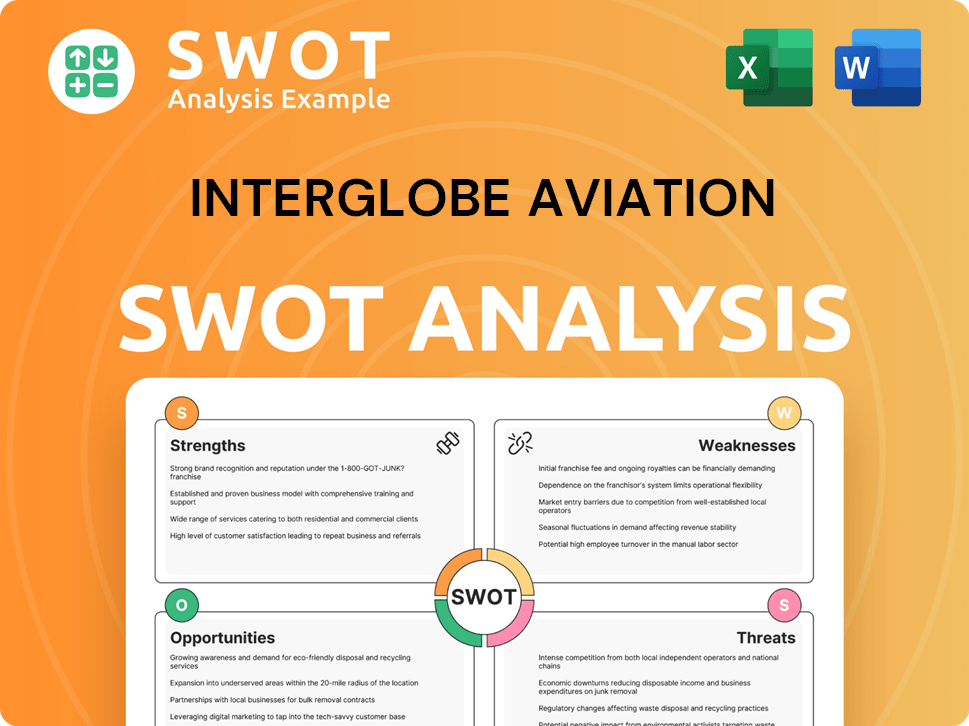
What Drove the Early Growth of InterGlobe Aviation?
The early growth of InterGlobe Aviation, or IndiGo, was marked by rapid expansion and strategic decisions that reshaped the Indian aviation market. IndiGo's journey began on August 4, 2006, with its inaugural flight, quickly establishing itself as a key player in the Indian aviation industry. This period was characterized by aggressive fleet expansion and a focus on a low-cost carrier model, contributing significantly to its early success.
IndiGo airline commenced operations in August 2006, starting with flights from Delhi to Imphal via Guwahati. The airline utilized a fleet of new Airbus A320 aircraft, setting the stage for its operational efficiency. By focusing on on-time performance and competitive fares, IndiGo quickly gained a foothold in the Indian aviation market.
A key element of IndiGo's early strategy was rapid fleet expansion. The company placed substantial orders for Airbus A320 aircraft to support its growth. This enabled IndiGo to quickly add new routes and increase its capacity, capitalizing on the growing demand for air travel in India. By 2011, IndiGo had already significantly expanded its domestic network and was ready for international expansion.
IndiGo's business model centered on the low-cost carrier approach. This strategy involved avoiding the complexities and costs associated with full-service airlines. This allowed IndiGo to offer lower fares, attracting a large customer base and driving its market share upwards. The airline's focus on direct bookings and promotional fares also contributed to its early customer acquisition.
In 2011, IndiGo received permission to operate international flights, launching its first international services to Dubai and Bangkok. This marked its entry into new geographical markets. By 2012, IndiGo's market share in the Indian aviation market had surpassed 20%, solidifying its position as a major player. Further insights can be found in the Competitors Landscape of InterGlobe Aviation.
InterGlobe Aviation PESTLE Analysis
- Covers All 6 PESTLE Categories
- No Research Needed – Save Hours of Work
- Built by Experts, Trusted by Consultants
- Instant Download, Ready to Use
- 100% Editable, Fully Customizable
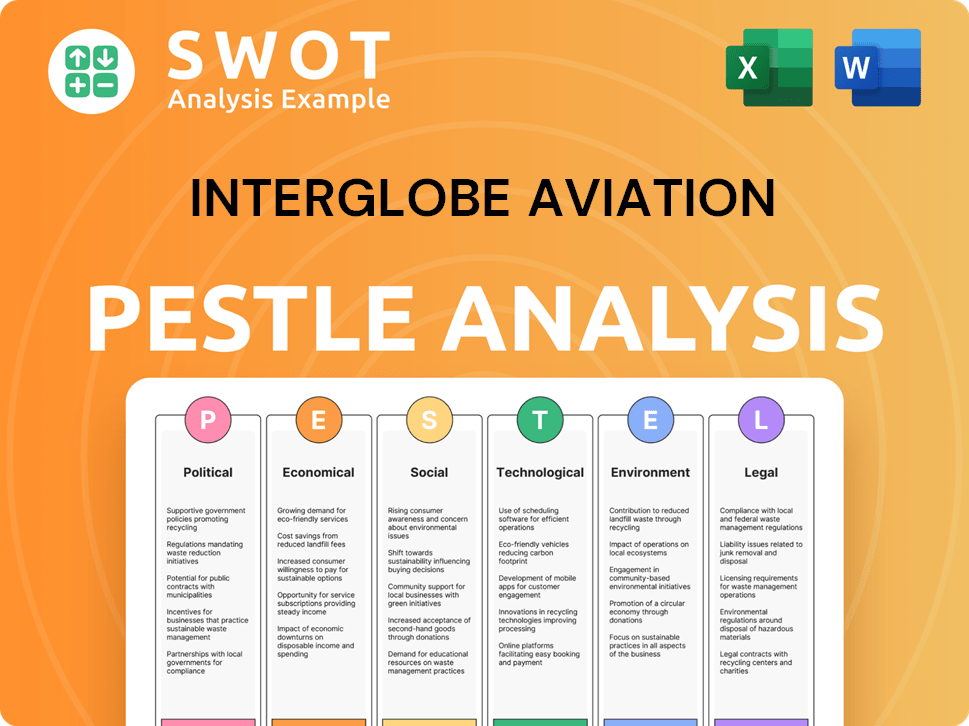
What are the key Milestones in InterGlobe Aviation history?
The InterGlobe Aviation, also known as IndiGo, has achieved several key milestones, significantly impacting the Indian aviation market. From its inception, IndiGo has grown to become a major player, consistently adapting to the dynamic challenges of the industry.
| Year | Milestone |
|---|---|
| 2006 | IndiGo commenced operations, entering the Indian aviation market as a low-cost carrier. |
| 2012 | IndiGo became India's largest airline by market share, a position it has largely maintained. |
| 2015 | InterGlobe Aviation successfully launched its Initial Public Offering (IPO). |
| 2019 | IndiGo placed an order for 300 Airbus A320neo family aircraft, showcasing its commitment to long-term growth. |
| 2023 | IndiGo expanded its international routes, increasing its global footprint. |
IndiGo's success is partly attributed to its innovative approach to the low-cost carrier model. This involved maintaining a single aircraft type, streamlining operations, and focusing on high aircraft utilization.
IndiGo's strategy of operating primarily Airbus A320 family aircraft has simplified maintenance and training. This standardization has led to significant cost savings and operational efficiencies.
The airline's focus on quick turnaround times at airports allows for more flights per day. This high utilization rate maximizes revenue generation from each aircraft in its fleet.
IndiGo consistently prioritizes on-time performance, which enhances passenger satisfaction. This focus on punctuality helps build customer loyalty and brand reputation.
Strict cost control measures, including fuel hedging and efficient operational practices, have been crucial. These strategies help maintain profitability in a competitive market.
Strategic route planning and network expansion have been key to IndiGo's growth. The airline has continuously added new domestic and international destinations.
IndiGo has embraced digital technologies to improve customer experience and operational efficiency. This includes online booking, check-in, and real-time flight updates.
Despite its successes, IndiGo has faced several challenges in the competitive Indian aviation market. These include fluctuating fuel prices and operational issues.
The Indian aviation market is highly competitive, with numerous airlines vying for market share. This leads to price wars and pressure on profit margins.
Fluctuations in fuel prices significantly impact airline profitability, as fuel costs represent a substantial portion of operational expenses. IndiGo must manage these risks effectively.
Engine issues and other operational challenges can lead to flight delays and cancellations. These disruptions affect customer satisfaction and increase operational costs.
The COVID-19 pandemic severely impacted air travel, leading to reduced demand and financial losses. IndiGo responded by rationalizing its network and implementing cost-cutting measures.
Economic downturns can decrease demand for air travel, affecting revenue. IndiGo must adapt its strategies to navigate economic fluctuations.
Changes in aviation regulations can impact operations and costs. IndiGo must stay compliant and adapt to evolving regulatory environments.
InterGlobe Aviation Business Model Canvas
- Complete 9-Block Business Model Canvas
- Effortlessly Communicate Your Business Strategy
- Investor-Ready BMC Format
- 100% Editable and Customizable
- Clear and Structured Layout
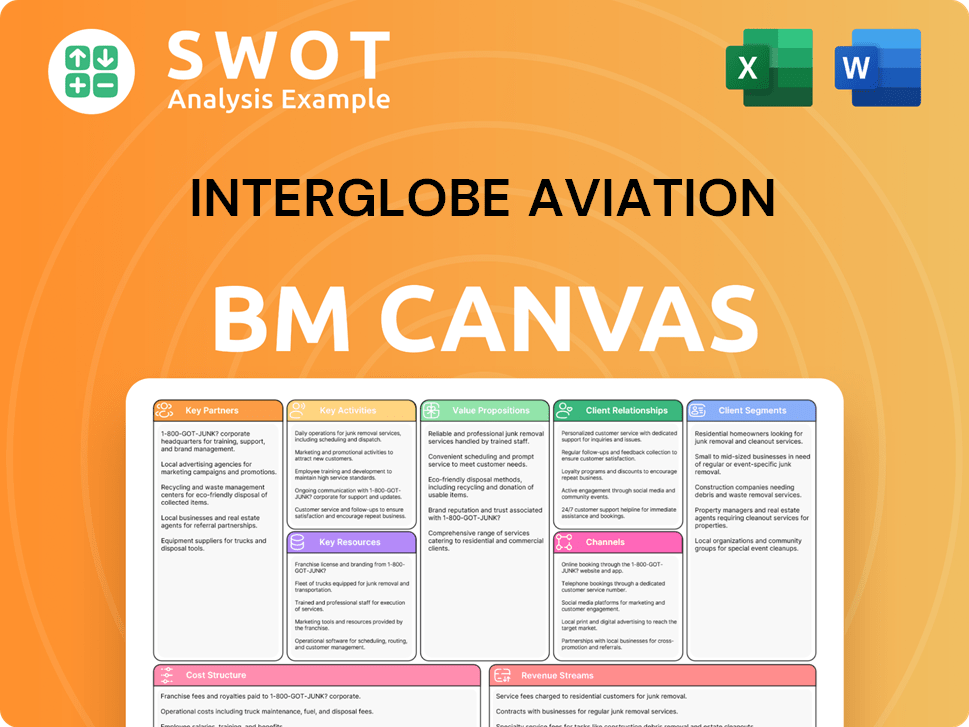
What is the Timeline of Key Events for InterGlobe Aviation?
InterGlobe Aviation, also known as IndiGo, has a rich history marked by significant milestones. The Mission, Vision & Core Values of InterGlobe Aviation have guided its growth. The company's journey from its inception to its current status as a leading airline is a testament to its strategic vision and operational efficiency. From its founding in 2006 to becoming the largest airline in India, IndiGo has consistently adapted to the dynamic aviation industry. The company has successfully navigated challenges and capitalized on opportunities, establishing a strong presence in the Indian aviation market.
| Year | Key Event |
|---|---|
| 2006 | InterGlobe Aviation, or IndiGo, was founded and began its operations, marking the start of its journey in the aviation industry. |
| 2011 | IndiGo launched its first international flights, expanding its network beyond domestic routes. |
| 2012 | The airline became the largest in India by market share, a significant achievement in the Indian aviation market. |
| 2015 | IndiGo successfully launched its Initial Public Offering (IPO), a key financial milestone. |
| 2019 | A substantial order for 300 Airbus A320neo family aircraft was placed, signaling future growth. |
| 2020 | The company faced and navigated the severe impact of the COVID-19 pandemic on air travel. |
| 2023 | Announced plans for significant international expansion and fleet growth, indicating a focus on global reach. |
| 2024 | IndiGo continues to hold a dominant market share in the Indian domestic aviation sector, exceeding 60%. |
IndiGo is actively expanding its international routes, aiming to connect more cities and increase its global footprint. This strategy leverages its strong domestic presence to enhance international connectivity. The airline is exploring new long-haul routes and enhancing its services to key international markets.
The airline's large order book for new aircraft supports sustained growth. IndiGo plans to increase its fleet size and expand its route network. This expansion is crucial for capturing a larger share of the growing passenger traffic in India and beyond.
IndiGo is investing in technology to improve customer experience and operational efficiency. Digitalization of processes and enhanced booking platforms are key areas of focus. These advancements help the airline maintain its competitive edge and streamline operations.
The increasing demand for air travel in India and the preference for low-cost carriers benefit IndiGo. The company is well-positioned to capitalize on this growth, maintaining its focus on affordability and punctuality. IndiGo's business model analysis indicates a continued emphasis on operational excellence and customer satisfaction.
InterGlobe Aviation Porter's Five Forces Analysis
- Covers All 5 Competitive Forces in Detail
- Structured for Consultants, Students, and Founders
- 100% Editable in Microsoft Word & Excel
- Instant Digital Download – Use Immediately
- Compatible with Mac & PC – Fully Unlocked
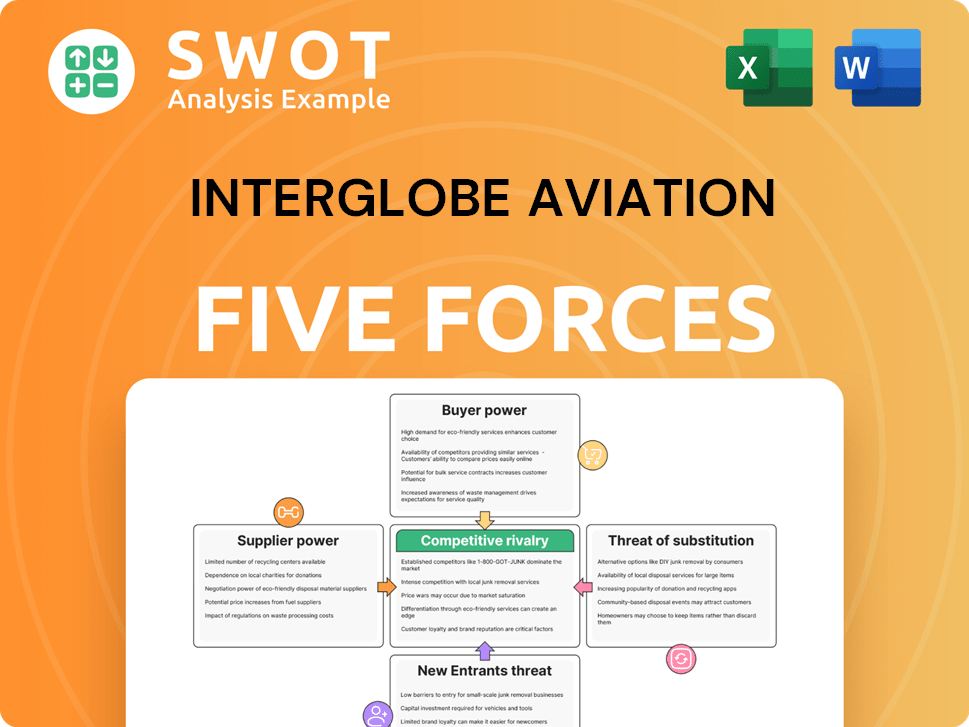
Related Blogs
- What is Competitive Landscape of InterGlobe Aviation Company?
- What is Growth Strategy and Future Prospects of InterGlobe Aviation Company?
- How Does InterGlobe Aviation Company Work?
- What is Sales and Marketing Strategy of InterGlobe Aviation Company?
- What is Brief History of InterGlobe Aviation Company?
- Who Owns InterGlobe Aviation Company?
- What is Customer Demographics and Target Market of InterGlobe Aviation Company?
Disclaimer
All information, articles, and product details provided on this website are for general informational and educational purposes only. We do not claim any ownership over, nor do we intend to infringe upon, any trademarks, copyrights, logos, brand names, or other intellectual property mentioned or depicted on this site. Such intellectual property remains the property of its respective owners, and any references here are made solely for identification or informational purposes, without implying any affiliation, endorsement, or partnership.
We make no representations or warranties, express or implied, regarding the accuracy, completeness, or suitability of any content or products presented. Nothing on this website should be construed as legal, tax, investment, financial, medical, or other professional advice. In addition, no part of this site—including articles or product references—constitutes a solicitation, recommendation, endorsement, advertisement, or offer to buy or sell any securities, franchises, or other financial instruments, particularly in jurisdictions where such activity would be unlawful.
All content is of a general nature and may not address the specific circumstances of any individual or entity. It is not a substitute for professional advice or services. Any actions you take based on the information provided here are strictly at your own risk. You accept full responsibility for any decisions or outcomes arising from your use of this website and agree to release us from any liability in connection with your use of, or reliance upon, the content or products found herein.